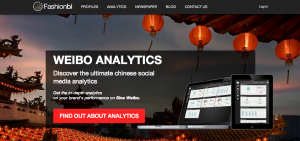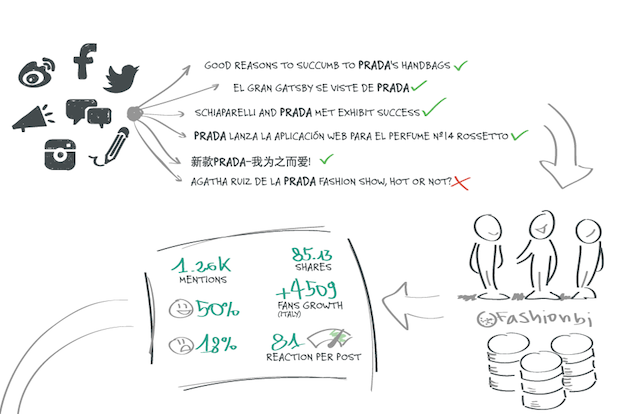Benchmarking Brands' Digital Strategies Worldwide, Company Zeroes In On Mainland#
Although China's fashion industry may only be in its infancy, we have seen top international brands flock to the country's fast-growing market over the past decade. Whether we're talking about a major city in China, Paris, New York, or London, we can see China's enthusiastic consumers are excited by fashion. This growth comes at a critical time for the development of digital marketing and e-commerce in China. Well-known international fashion houses like Hugo Boss, Zara, and Coach have all launched official online stores in the country, and we now see Chinese fashionistas going not only offline, but also online for fashion products, news, and trends.
For marketers hoping to gain insight into this flurry of online fashion activity, a new information source called Fashionbi has arrived on the scene. Fashionbi is the first database to track the digital marketing activities of fashion and luxury brands worldwide. From this global perspective, Fashionbi CEO Simone Lovati, who recently joined Jing Daily for an interview, has noted the tremendous business opportunities that China's fast-developing digital world can bring to these market sectors. “The Chinese are the most relevant engine of demand for the fashion and luxury industry,” he said.
How does a luxury fashion brand seize this digital momentum to pave the way in the Chinese fashion industry and cater to more Chinese online users? With this question in mind, Jing Daily talks to Lovati about his opinion on China's digital fashion sector and his advice for fashion brands entering the Chinese digital market.
Could you please briefly introduce Fashionbi to our audiences? What's the background of setting up the company?#
Nowadays, the direction of the fashion industry is always toward being more present online. From bricks to clicks, the multi-channel experience is becoming the driver of growth.
For this reason, fashion and luxury brands are switching more of their investments into the digital world—a magic place, where everything seems new, and it is not so easy to have a clear picture of the ROI [return on investment].
The company board does not care about "fans", "likes", and "comments". In the end, what they really want to know is the result for their business. In terms of understanding the impact of these digital efforts for the business, to be honest, there is a lack of benchmarks; a big gap of reliable data. Fashionbi fills this gap. It is a big database about all the digital marketing performances of fashion and luxury brands worldwide. If someone in one of the 90 countries that we are monitoring is writing something, for example, about Gucci, the information is gathered and stored in our database.

Fashionbi founder Simone Lovati.
What are Fashionbi's business strategies and services related to the Chinese market?#
We are working in two directions: helping managers to optimize, and helping agencies to increase their value for money.
We help managers to audit, control, and optimize their investment in digital media by providing a dashboard of KPI [key performance indicators] based on deep quantitative and qualitative research on Chinese blogs, forums and news sites. Plus, it is the first time for a Western company to store and analyze big data coming from native and real-time connections with a main Chinese social media network like Weibo.
As for the marketing agencies, our value proposition is very simple. Everyone knows that in digital marketing, software research is not enough; you have to spend hours before finding real insights for the clients.
We simply do the dirty job for them, reading everything and giving them the most relevant content to analyze. In this way, they can focus on insights and "actionables".
How do you position China in the global fashion scene? What are China's strengths and weaknesses?#
Nowadays, the Chinese are the most relevant engine of demand for the fashion and luxury industry, and it will be continuing in this way for the next five years. The consumer culture is fast-growing in a way that is shocking European and American brands. This is a strength and a weakness.

Approximately 200 fashion and luxury brands are on Weibo.
Fashionbi recently launched a digital issue named “The Fashion Revolution in China: From Offline to Online”. How do you see China's digital fashion sector?#
"Fashion and luxury" is the largest e-commerce category in China, accounting for 27 percent of online sales, versus 18 percent in the United States, based on the "2011-2012 China Online Clothing Shopping Report” by iResearch from January 2013.
This volume will triple in only three years. Despite this huge opportunity, to be honest, I don't see so many brands doing direct e-commerce strategies on their Chinese websites. Approximately 200 fashion and luxury brands are on Weibo, based on Fashionbi Analytics
from May 2013, but very few of them are really engaging with people. The result is counterfeits, a price-driven market, and a proliferation of online sales based on peer-to-peer media like Taobao. The future will be very different, because consumer experience has now become the pillar of brand strategy; not the product.
All the brands sooner or later have to control and tune their CX [consumer experience], staying very close to the consumers. For this reason, they will have to open their own e-commerce for Chinese consumers, and manage directly all the touch-points in the multi-channel experience. We are there to help them.
With online fashion becoming a global trend, we have also seen luxury and fashion brands, as well as department, stores rushing into China's digital fashion world, such as Neiman Marcus, Hugo Boss, and Coach, to name a few. What is your advice for a fashion brand entering the Chinese digital market?#
Don't look at China, but at the Chinese. The secret is not finding out a way to sell fast and easy in their countrY, but staying strong with these people during their life on the mainland and abroad. For this reason, I think that the local approach must be replaced with a more flexible and consistent consumer approach. The Chinese are always inclined to be "citizens of the world". Think about people instead of target—it is just a good starting point.
